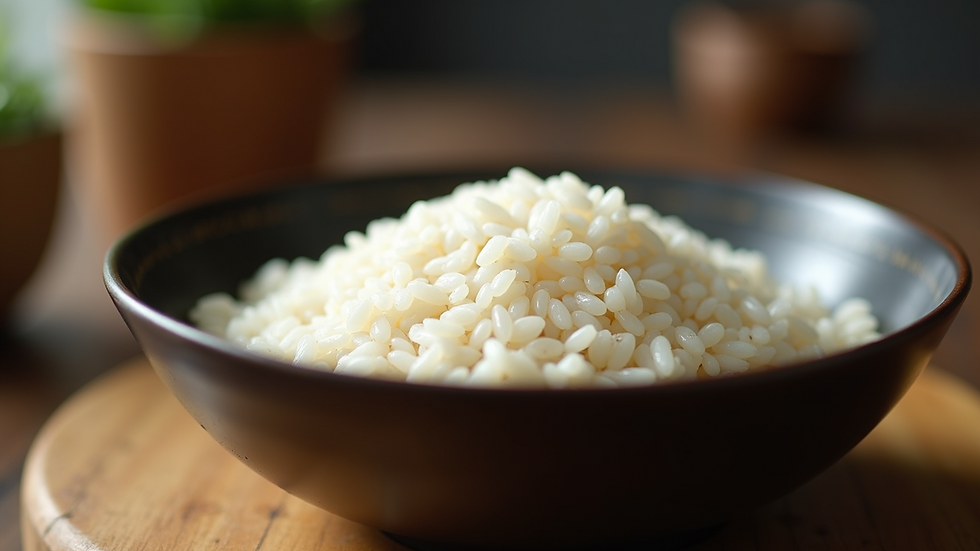How to Make Your Own Makgeolli at Home
- TaeGye LEE
- Oct 4
- 4 min read
Makgeolli is a traditional Korean rice wine that has been enjoyed for centuries. It is a milky, slightly sweet alcoholic beverage with a unique tangy flavor. Making your own makgeolli at home can be a rewarding experience, allowing you to enjoy this delicious drink fresh and customized to your taste. This guide will walk you through the process step-by-step, providing practical tips and insights to help you brew your own batch successfully.
Understanding Makgeolli and Its Ingredients
Makgeolli is made primarily from rice, water, and a fermentation starter called nuruk. Nuruk is a traditional Korean fermentation starter that contains natural yeast and enzymes, which help convert the starches in rice into sugars and then into alcohol. The process is similar to brewing beer or sake but has its own unique characteristics.
To make makgeolli, you will need:
Short-grain rice (preferably sweet rice or glutinous rice)
Nuruk (available at Korean grocery stores or online)
Water (filtered or spring water is best)
Sugar (optional, to adjust sweetness)
The quality of your ingredients will directly affect the flavor and texture of your makgeolli. Using fresh nuruk and clean water is essential for a good fermentation process.

Step-by-Step Guide to Making Makgeolli
Making makgeolli involves several stages: washing and soaking the rice, steaming, mixing with nuruk and water, fermenting, and finally bottling. Here’s a detailed breakdown:
1. Preparing the Rice
Start by washing 2 cups of short-grain rice thoroughly until the water runs clear. This removes excess starch and impurities. Soak the rice in water for about 4 hours or overnight to soften the grains.
2. Steaming the Rice
Drain the soaked rice and steam it for about 40 minutes until fully cooked but still firm. Avoid overcooking as mushy rice can affect fermentation. Let the rice cool to room temperature.
3. Mixing Ingredients
In a clean fermentation container, combine the steamed rice with 1 cup of nuruk and 4 cups of water. Stir well to break up the rice and mix everything evenly. You can add 2 tablespoons of sugar at this stage if you prefer a sweeter makgeolli.
4. Fermentation
Cover the container loosely with a cloth or lid to allow airflow but prevent contaminants. Keep it at room temperature (around 20-25°C) for 7 to 10 days. Stir the mixture once daily to help fermentation and prevent mold.
5. Straining and Bottling
After fermentation, strain the liquid through a fine mesh or cheesecloth into clean bottles. The liquid should be milky and slightly fizzy. Store the bottles in the refrigerator and consume within 1-2 weeks for the best taste.

Can Makgeolli Make You Drunk?
Makgeolli typically has an alcohol content of 6-8%, which is lower than many other alcoholic beverages like wine or spirits. However, it can still make you drunk if consumed in large quantities. The fermentation process produces alcohol naturally, and the drink’s milky texture and sweetness can make it easy to drink quickly.
It’s important to enjoy makgeolli responsibly. Because it is unfiltered and contains live cultures, it can also have a slight effervescent effect, which might increase the perception of intoxication. If you are new to makgeolli, start with small servings and see how your body reacts.

Tips for Perfecting Your Homemade Makgeolli
Making makgeolli at home can be a fun experiment, but it may take a few tries to get it just right. Here are some tips to improve your brewing process:
Use fresh nuruk: Old or stale nuruk can lead to poor fermentation or off-flavors.
Maintain clean equipment: Sanitize all containers and utensils to avoid contamination.
Control temperature: Keep the fermentation environment stable and avoid extreme heat or cold.
Adjust sweetness: Experiment with adding sugar or honey to suit your taste.
Try different rice types: While glutinous rice is traditional, you can try other varieties for unique flavors.
Be patient: Fermentation times can vary depending on conditions; taste your makgeolli regularly.
For more detailed insights and recipes on traditional Korean beverages, check out this korean rice wine resource.
Exploring the Cultural Significance of Makgeolli
Makgeolli is more than just a drink; it holds a special place in Korean culture. Historically, it was a common beverage among farmers and workers due to its affordability and nutritional value. Today, it is enjoying a resurgence in popularity both in Korea and internationally.
Drinking makgeolli is often a social activity, accompanied by Korean dishes like pajeon (green onion pancakes) or kimchi. Its slightly tangy and creamy profile pairs well with spicy and savory foods, making it a versatile choice for meals and celebrations.
By making your own makgeolli, you connect with a rich tradition and gain a deeper appreciation for Korean culinary heritage.
Experimenting with Flavors and Variations
Once you have mastered the basic makgeolli recipe, you can start experimenting with flavors. Some popular variations include:
Adding fruits: Incorporate sliced pears, apples, or berries during fermentation for a fruity twist.
Herbal infusions: Try adding ginger, cinnamon, or ginseng for added aroma and health benefits.
Sweeteners: Use honey, brown sugar, or malt syrup instead of white sugar for different sweetness profiles.
Carbonation: For a fizzy makgeolli, allow a secondary fermentation in sealed bottles for a few days.
These variations can make your homemade makgeolli unique and tailored to your preferences.
Making your own makgeolli at home is a rewarding journey into traditional Korean brewing. With simple ingredients and a bit of patience, you can enjoy fresh, delicious makgeolli anytime. Whether you drink it casually or share it with friends, this homemade korean rice wine offers a taste of Korea’s rich cultural heritage right in your own kitchen. Cheers to your brewing adventure!



Comments